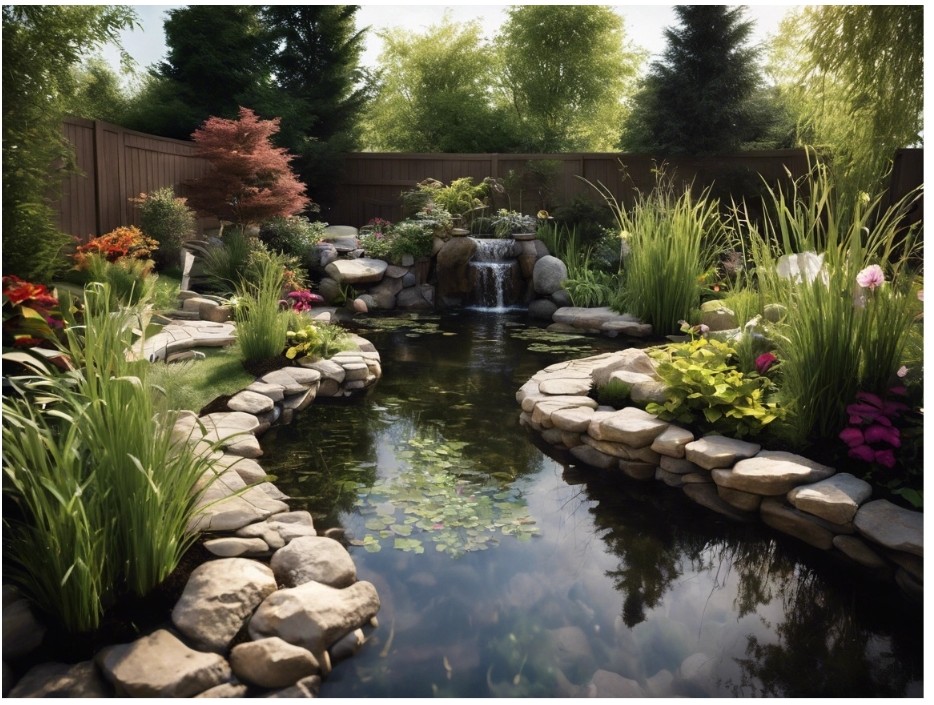Creating a backyard fish pond can transform your outdoor space into a peaceful oasis, adding both beauty and tranquility. Whether you’re a hobbyist seeking to build a haven for colorful fish or simply want to enhance your garden with a soothing water feature, constructing and maintaining a fish pond is a rewarding project. This guide will walk you through essential steps to design, build, and offer the best fish pond maintenance tips to keep it thriving.
Step 1: Planning Your Fish Pond
Before diving into construction, thoughtful planning is crucial. Decide on the size and location of your pond. Ideally, choose a spot that gets partial sunlight and isn’t directly under trees, as falling leaves can make maintenance harder. Consider the depth of your pond, especially if you plan to introduce fish like koi or goldfish, which require a bit more space to swim and grow. Check out this article for some other great backyard pond ideas.
Key considerations:
Size & shape: Larger ponds are easier to maintain because they create more stable environments for fish and plants.
Depth: A depth of at least 2-3 feet is recommended to protect fish from predators and ensure water doesn’t freeze completely in winter.
Filtration: Installing a reliable filtration system is essential to keep the water clean and oxygenated.
Step 2: Building the Pond
Once you’ve planned your pond, it’s time to start digging! Begin by marking the area with string or spray paint. Dig according to the desired shape and depth, making sure to create ledges where aquatic plants can be placed. Line the pond with a quality pond liner to prevent leaks, and secure it with rocks or stones along the edges.
Next, install your pond pump and filtration system. These are crucial for maintaining water flow, which helps keep the water fresh and prevents algae buildup. For a natural look, you can disguise the equipment with rocks, plants, or decorative features like waterfalls.
Step 3: Introducing Fish and Aquatic Plants
With your pond built and filled with water, it’s time to introduce fish and plants. Goldfish and koi are popular choices because of their vibrant colors and adaptability. Start with just a few fish to avoid overcrowding, and let them adjust to the water’s temperature before releasing them into the pond.
Aquatic plants, such as water lilies, marginal plants, and floating varieties like duckweed, not only beautify the pond but also help balance the ecosystem. Plants provide shade, oxygen, and natural filtration, making them essential for a healthy pond.
Fish Pond Maintenance Tips
Once your pond is set up and thriving, regular maintenance is key to ensuring its longevity and the health of your fish. Follow these fish pond maintenance tips for a hassle-free and beautiful pond:
1. Monitor Water Quality
Monitoring water quality is the most important factor in maintaining a healthy fish pond. Test the water regularly for pH, ammonia, nitrite, and nitrate levels. Ideally, the pH should be between 6.8 and 8.0, while ammonia and nitrite levels should always be at zero. You can use a pond water test kit for accurate readings.
2. Control Algae Growth
Algae growth can quickly take over a pond if left unchecked. To control algae, limit the amount of direct sunlight by adding more floating plants, which provide shade. A UV pond clarifier can also be helpful, as it kills algae spores before they can bloom. Avoid overfeeding your fish, as uneaten food contributes to algae growth.
3. Regular Filter Cleaning
The pond’s filtration system works hard to keep the water clear, but it needs regular cleaning to function properly. Check the filter weekly and clean it according to the manufacturer’s instructions. This will prevent debris buildup and ensure proper water circulation.
4. Remove Debris
Leaves, twigs, and other debris can accumulate in your pond, especially in autumn. Use a pond skimmer or net to remove floating debris regularly. This simple step can prevent water quality issues and reduce strain on the filter system.
5. Seasonal Pond Care
Fish ponds require different care throughout the year:
Spring: Perform a partial water change and check the filtration system after winter.
Summer: Ensure proper aeration as warm temperatures reduce oxygen levels in the water.
Autumn: Remove fallen leaves promptly and prepare your pond for winter by cutting back plants.
Winter: If you live in a cold climate, install a pond heater or de-icer to keep a small area of the pond ice-free, allowing oxygen exchange for your fish.
6. Feed Fish Moderately
Overfeeding is one of the most common mistakes pond owners make. Fish should only be fed what they can consume in a few minutes. Uneaten food sinks to the bottom and decays, leading to poor water quality and algae blooms. During colder months, fish metabolism slows down, so feed them less or stop feeding altogether when the water temperature drops below 50°F (10°C).






